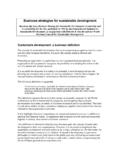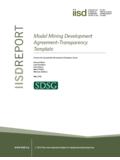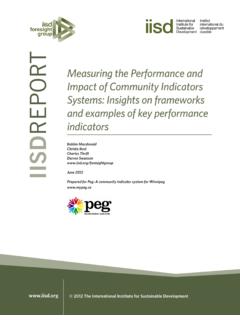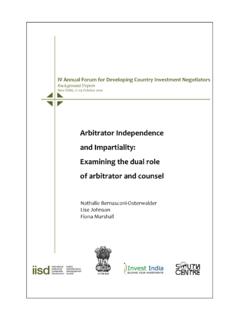Transcription of Corporate Social Responsibility
1 Corporate Social Responsibility An Implementation Guide for BusinessPaul Hohnen, AuthorJason Potts, EditorCorporate Social Responsibility An Implementation Guide for BusinessPaul Hohnen, AuthorJason Potts, Editor 2007, international Institute for Sustainable DevelopmentThe international Institute for Sustainable development contributes to sustainable devel-opment by advancing policy recommendations on international trade and investment,economic policy, climate change and energy, measurement and assessment, and sus-tainable natural resources management. Through the Internet, we report on internationalnegotiations and share knowledge gained through collaborative projects with globalpartners, resulting in more rigorous research, capacity building in developing countriesand better dialogue between North and s vision is better living for all sustainably; its mission is to champion innovation,enabling societies to live sustainably.
2 IISD is registered as a charitable organization inCanada and has 501(c)(3) status in the United States. IISD receives core operating sup-port from the Government of Canada, provided through the canadian InternationalDevelopment agency (CIDA), the international development Research Centre (IDRC)and Environment Canada; and from the Province of Manitoba. The Institute receives proj-ect funding from numerous governments inside and outside Canada, United Nationsagencies, foundations and the private Institute for Sustainable Development161 Portage Avenue East, 6th FloorWinnipeg, ManitobaCanada R3B 0Y4 Tel.
3 : +1 (204) 958-7700 Fax: +1 (204) 958-7710 Web site: Social Responsibility : An Implementation Guide for BusinessISBN 978-1-895536-97-3 Paul Hohnen, AuthorJason Potts, Editor This document is available at Social Responsibility : An Implementation Guide for BusinessiiAcknowledgementThis guide reflects the inputs of many experts from around the world, including those listedin Appendix 1. IISD wishes to acknowledge in particular the lead authorship of theGovernment of Canada in the drafting of the original canadian guide. The present guidewas written by Paul Hohnen and edited by Jason Potts of Social Responsibility : An Implementation Guide for BusinessiiiCorporate Social Responsibility : An Implementation Guide for BusinessivTa ble of ContentsPreface viiIntroduction1 Responsible business is good business 1 About this guide 3 Part 1: An overview of Corporate Social Responsibility 4 What is the business case for CSR?
4 9 Potential benefits of implementing a CSR approach 11 Real firms are reporting real benefits from CSR13 What is the relationship between CSR and the law? 15 Part 2: Implementing Corporate Social responsibility18 Task 1: Conduct a CSR assessment22 Task 2: Develop a CSR strategy32 Task 3: Develop CSR commitments42 Key international CSR initiatives of governmental or 52intergovernmental bodies CSR and Human Rights54 Task 4: Implement CSR commitments57 Task 5: Report and verify progress67 Task 6: Evaluate and improve73 Part 3: The importance of stakeholder engagement76 Task 1: Identify stakeholders 79 Task 2: Understand the reason for stakeholder engagement80 Task 3: Plan the engagement process 80 Task 4: Start the dialogue 81 Task 5.
5 Maintain the dialogue and deliver on commitments 81 Appendix 1: External Multi-Stakeholder CSR Expert Advisory Group 86 Appendix 2: Corporate Social Responsibility organizations88 Appendix 3: Key international CSR instruments 93 Appendix 4: Non-governmental CSR-related codes and standards initiatives98 Appendix 5: National CSR guidance102 Further reading103 Corporate Social Responsibility : An Implementation Guide for BusinessvCorporate Social Responsibility : An Implementation Guide for Businessvi Our biggest challenge this century is to take an idea that seemsabstract sustainable development and turn it into a reality for all theworld s peoples.
6 Kofi Annan, former UN Secretary GeneralPreface One of humankind s greatest challenges this century will be to ensure sustainable, justand balanced development . The needs of current and future generations cannot be metunless there is respect for natural systems and international standards protecting coresocial and environmental values. In this context, it is increasingly recognized that the roleof the business sector is critical. As a part of society, it is in business interest to con-tribute to addressing common problems. Strategically speaking, business can only flour-ish when the communities and ecosystems in which they operate are broad strategic context helps explain the growing appetite among businessesworldwide for authoritative information, company examples and advice about corporatesocial Responsibility (CSR).
7 This guide has been developed by the international Institutefor Sustainable development (IISD) to help respond to that demand. Importantly, theguide should also be useful to the many firms that do not currently have formal CSR poli-cies or programs in place. While not specifically developed for use by public agenciesand civil society organizations, the principles of CSR may also be helpful to them in theirown sustainability guide, which draws heavily on a 2005 guide prepared by the Government of Canadafor a canadian audience, aims to provide practical guidance to companies operating inthe international this in mind, we have made a special effort to highlightissues and examples from around the guide is primarily intended as an introduction to some of the existing CSR tools andapproaches which are currently being used.
8 In publishing this guide, we aim to providea useful starting point for accessing the many CSR instruments currently available in themarketplace. Governments, multilateral organizations, non-governmental organizationsand other groups have devoted considerable time and energy to the promotion of cor-porate Social Responsibility giving rise to a vast repository of CSR initiatives, instrumentsand resources. Among the better known international instruments this guide draws on include: The Organisation for Economic Co-operation and development (OECD)Guidelines for Multinational Enterprises; The international Labour organization (ILO) Tripartite Declaration ofPrinciples concerning Multinational Enterprises and Social Policy and CoreLabour Standards; The UN Global Compact Principles;1 Corporate Social Responsibility : An implementation guide for canadian business, Social Responsibility : An Implementation Guide for Businessvii The Global Reporting Initiative (GRI) Sustainability Reporting Guidelines.
9 The international organization for Standardization (ISO) standards; The AccountAbility AA1000 Series; and The Social Accountability international SA8000 is hoped that businesses and other organizations interested in implementing a CSRapproach will use this guide as a point of departure for CSR design and guide reviews key issues to consider, offers options for addressing them and refersto many specific tools that could be of most assistance. Actual implementation of anyspecific CSR activities will almost certainly involve the use of one or more of the tools ref-erenced in this guide. Our purpose is to provide a framework for helping corporateCEOs, managers and employees navigate across the sea of existing CSR instruments.
10 Readers should note that this guide considers CSR to be only one aspect of a compre-hensive multi-stakeholder effort to improve environmental and Social conditions and pre-vent harm. The complementary actions of all sectors of society governments, non-gov-ernmental organizations, citizens and others are also that choose to implement a CSR approach should note that this will involve adynamic learning process, for which this guide is merely one source of information andassistance. Sustainable development and CSR are moving targets that cannot be fully achieved by one-time activities and decisions.








